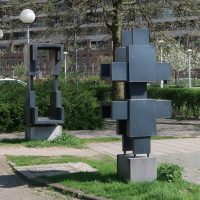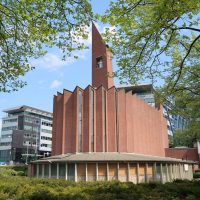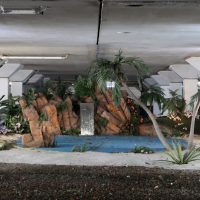Constructie met I-balken, André Volten, 1968
Oostoever/Bonnefantenstraat
The rectangular and the linear in order not to act unrestrained
In 1902 a book of Dutch idioms and proverbs, collected and edited by Frederik August Stoett, was published. He collected and numbered all the proverbs he could find. Number 155 says: ‘Uit den band springen’, which translates as to burst, to fly open. It refers to a barrel and the metal rings around it breaking open from internal pressure, meaning as much as to act unrestrained.
The proverb pops up in an interview for Ons Erfdeel with the constructivist sculptor André Volten, when his practice and his emotional and intuitive approach to material are discussed. When asked why he deals with sculpture on such mathematical terms he uses the Dutch saying to clarify his approach: ‘I need the rectangular and the linear in order to restrain myself.’
The creative process and the creator form a perfect balance. But also in the work itself the balance between the elements is of great importance. The tripartite metal construction Constructie met I-balken (construction with I-beams) stood on Museumplein for years, right next to the Stedelijk Museum. When the work had to move the municipality and the artist found this new location.
The works is regarded one of the masterpieces of Dutch constructivist sculpture. That is why, in the late 1990s, the Amsterdam Fund for the Arts wanted to place the work on an expensive marble pedestal, the price tag for which turned out to be some 70.000 Dutch Guilders. Volten thought of it as a senseless waste of money, illustrating that also in this situation he did not wish to act unrestrained. Equally praiseworthy was his counter-proposal: to renovate the artwork Groot Landschap by his colleague Wessel Couzijn on the other side of the Sloterplas.
More information
Boyens, José (2001) ‘André Volten en de muziek van de ruimte’. In: Ons Erfdeel, jaargang 44 nummer 5, Stichting Ons Erfdeel, Rekkem / Raamsdonksveer, pp 740-748.












